Wednesday Nov 26, 2025
Wednesday Nov 26, 2025
Friday, 3 January 2020 00:00 - - {{hitsCtrl.values.hits}}
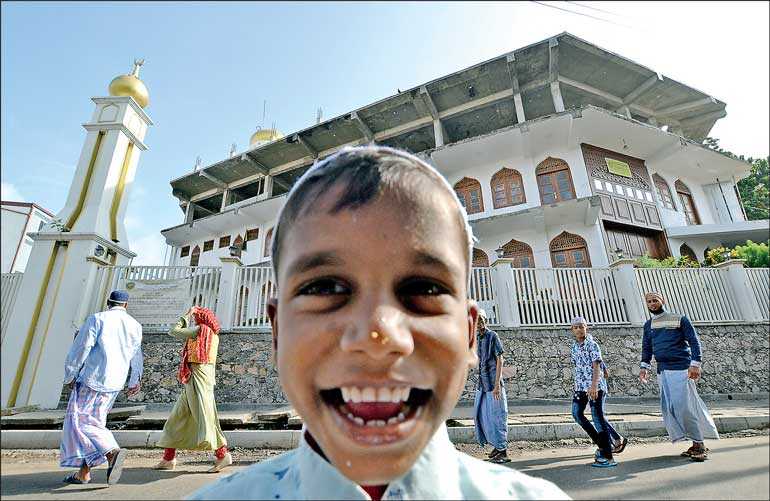
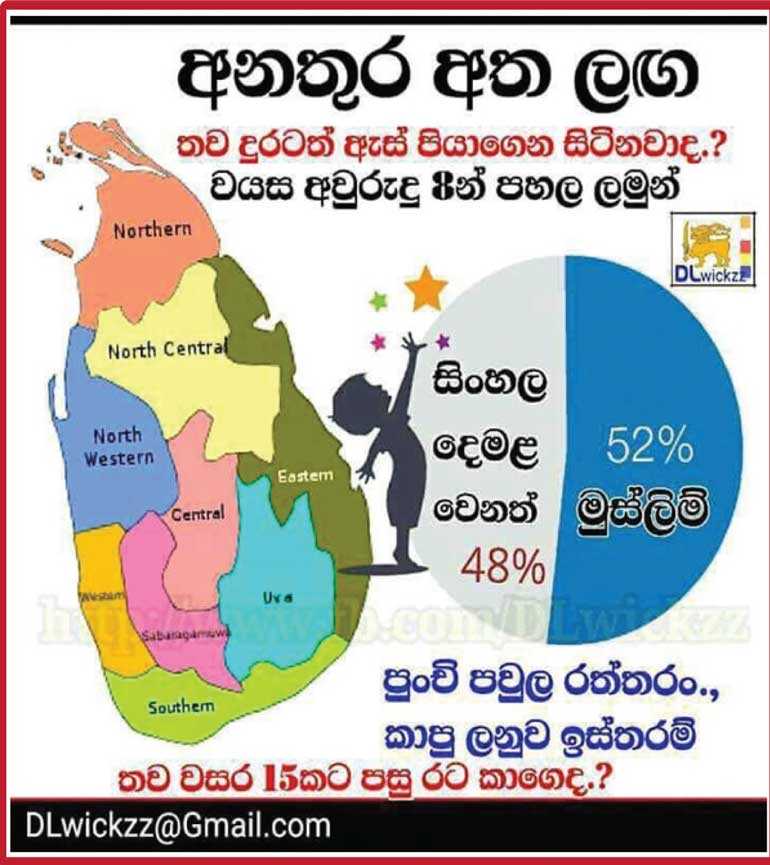
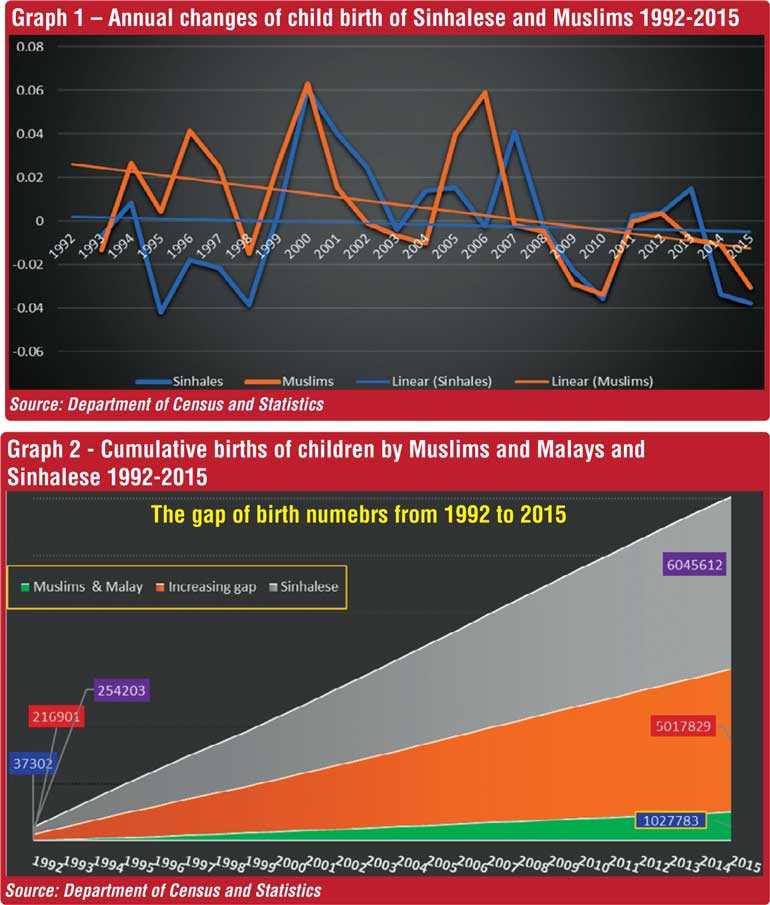
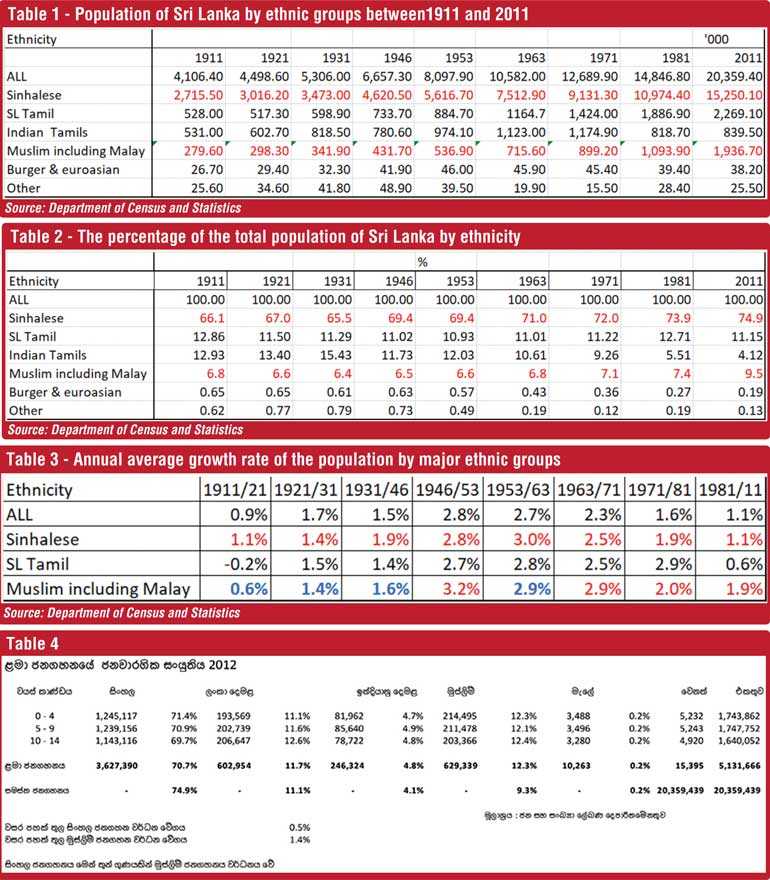
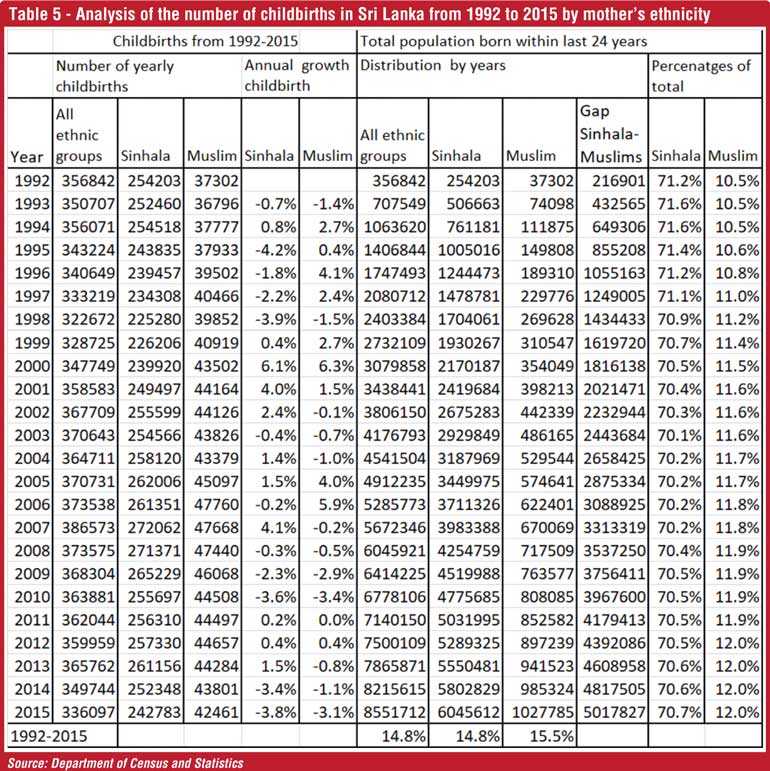
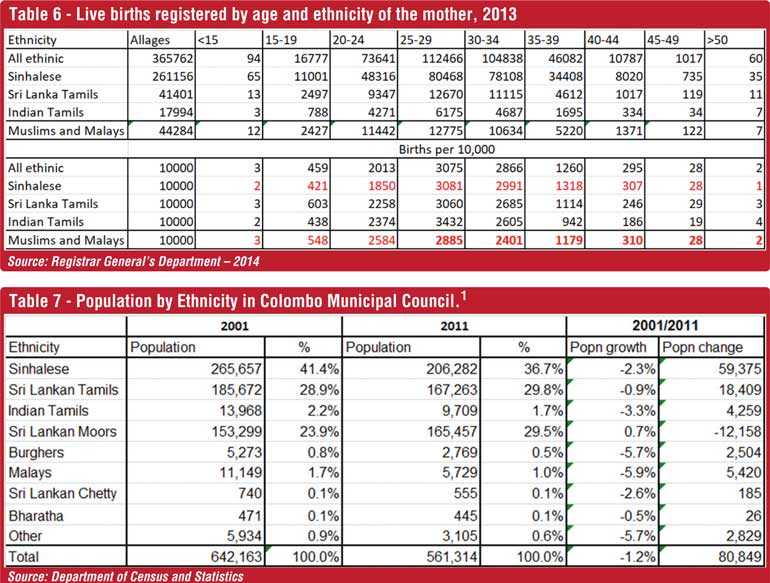
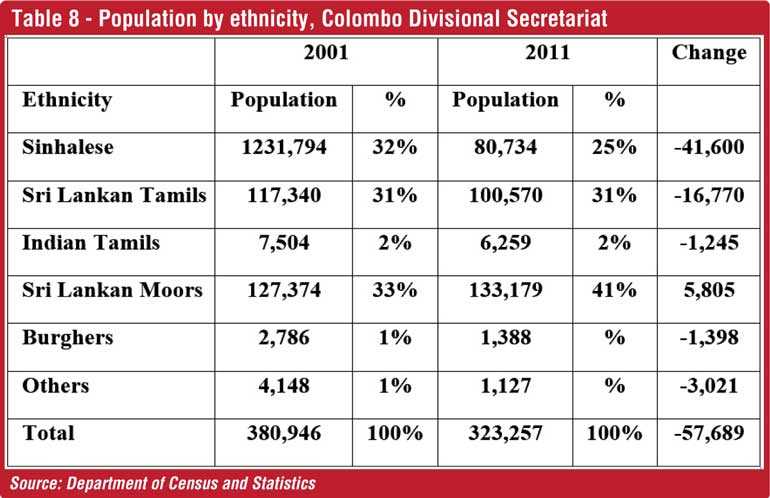
By Nimal Siripala
Anti-Muslim campaigns have been on the rise in the recent past across Sri Lanka – raising the spectre of Muslims being an existential threat to Buddhism and the Sinhala race due to their increase in numbers and growing economic domination.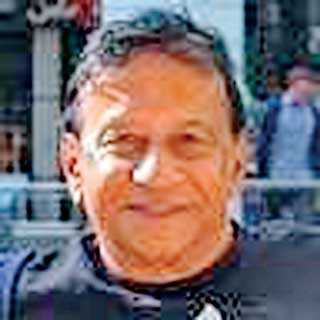
The perceived demographic threat that Muslims will overtake the Sinhala race in size of the population is a fallacy that has gained ground and, coupled with the claim that the wealth of the nation is under the control of Muslims, has contributed to producing a fear psychosis in the minds of even moderate Sinhala Buddhists. This, in turn, fuels the already vicious rhetoric of hardliners who are bent on causing disaffection among the largely cohesive, peace-loving people of this country. The public discourse is a growing hotbed of misinformation, distortion and fear-mongering.
People who hold extreme views blame those who contradict them as representatives of NGOs funded by the West or sponsored by Muslims. Therefore, it is essential that moderate people of all communities discuss some of these falsehoods openly rather than leaving space for extremists on both sides to throw unsubstantiated accusations.
The three prevalent fallacies circulating in the media, including social media, and in places of worship and public gatherings, are that:
1. The Muslim community is growing so fast that by 2100 Sri Lanka will become a Muslim majority country.
2. In 15 years, Muslim children under eight years of age in Sri Lanka will be 52% of the national population.
3. The Sinhalese population in Colombo, which was 51% in 1951, has already plunged to 10%.
Fallacy 1: The Muslim community is growing so fast that by 2100 Sri Lanka will become a Muslim majority country
This essay addresses all these misconceptions starting with the fallacy that the Muslim community is propagating so fast that Sri Lanka will soon be a Muslim majority country.
This is the most sweeping statement that influences the Sinhalese to feel a sense of insecurity for their children’s future and fear that the Sinhala Buddhist nation would soon come to an end.
The relatively high growth rates of the Muslim population between 1981 and 2011, compared to that of non-Muslims, have been perceived as a threat to the dominant position of the Sinhalese. As this has become an issue of concern to many, it was raised at an official gathering held at the Hector Kobbekaduwa Agrarian Training and Research Institute (HARTI) recently.
Answering a query raised by the audience, the Director –Population Census and Demography Division of the Department of Census and Statistics Ms Indu Bandara stated: “Sinhala and Muslim populations had increased at the rate of 1.04% and 1.87% respectively between 1981 and 2012, but it is not a threat to the Sinhala people, contrary to claims made in some quarters.” She further added, “It is also false to state that the Muslim population is higher than the Sinhala population within the Colombo Municipal Council area.”1
A full-page article published in a national newspaper used official demographic statistics* to convince readers that the Sinhalese population is diminishing while the Muslim community is increasing. This article was highlighted during an early morning TV program. Again, on 30 May 2018, it was followed by another article by the same writer concluding (translated): “According to the Census data, it seems that Muslims will be the majority in the country.” This article, too, using population statistics, argued that Muslims would become the majority in this country.
Official figures indicate an increase in Muslim population as a percentage of the total population from 7.4% (1981 census) to 9.5% (2011 census) – meaning total Muslim population has increased by 78% during these 30 years. This is a piece of information that is used continuously to build several alarmist scenarios and amplify the fallacy that Sri Lanka will become a ‘Muslim country’ in 2100.
Parliamentarian Udaya Gammanpila has held an extraordinary press conference at which he claimed that he has obtained unpublished data of the 2012 Census from the Department of Census and Statistics (DCS). With this data, he states that he can confirm that the Sinhala population will be extinct because the Muslim child population, as a percentage of the total child population, is higher than that of the Sinhalese child population and has increased by three times compared with the increase of the Sinhala population.2
This is a decisive turn in this debate as he has used official data of the child population to analyses general population growth. But, analysed further, it shows that his interpretation is incorrect and data used is inappropriate to explain population growth.
Therefore, this essay presents a more comprehensive analysis to refute this dramatisation and persuade readers to address these issues based on evidence.
First, let us see the historical population dynamics. According to Table 1 in the 80 years 1931-2011, the total population of the country increased by over 15 million with the increase in the number of the Sinhala community being over 12 million and the Muslim community a little over 1.7 million.
During the period 1981 to 2011, the Muslims had the highest annual average percentage growth of 2.6%. Based on this rate, the 2011 Muslim population of 1,936,700 would take nearly 200 years to come even close to the 2011 Sinhala population of 15,250,100, assuming that the Sinhala population would remain static during this time is very unlikely. Thus, during both periods when one Muslim person was added to the population, the Sinhalese added an average of seven. Therefore, the notion of the Muslim population exceeding that of Sinhala population by Muslims is a long-distance target that can succeed only if the Muslim had a continuous increase of population growth more than Sinhalese for several hundred years to come.
It is essential to open a space to analyse the multiple factors that affect the growth of communities, rather than making projections based on one period.
According to table 2, there is a continuous increase in the proportion of Sinhalese from 65.5% in 1931 to 74.9% in 2011. As a percentage share, the Sinhala population has risen by 9.4% units (or 11.8 million people). During this period, the Sinhala population has increased as a percentage of the total population much higher than that of all other communities. The other ethnic group which has shown a continuous increase in its proportion is the Muslims, but at a slower rate compared to that of the Sinhalese. They have increased their population share from 6.4 % to 9.5. The population of all other ethnic groups, as a percentage of totals, has either been constant or has declined.
If the two full censuses of 1981 and 2011 are compared, the Sinhalese did not achieve the same rate of increase they had made earlier. Instead, their proportion has increased only by 1% (4.2 million) whereas the Muslims had a 2.1% (0.8million) increase. Without considering the historical changes, this recent increase of the population of Muslims has been used to portray a false scenario of grave danger to the Sinhala Buddhists of Sri Lanka being turned into a minority.
According to table 3, the average growth pattern between censuses during the last 100-year period, the population growth of Muslims was not always higher than the growth of the Sinhala population. The growth rate of Muslims also keeps diminishing but at a lower rate than that of the Sinhalese.
Considering the migration and other social development of the community such as education, late marriages and women engaging in employment current growth rate of Muslim population will start falling as time goes. It was noted that the average age of marriage for Muslim women is increasing.
Currently, Muslim women’s average age of marriage differs from the Sinhalese by less than one year. According to the 2011 Census, the average age of marriage for Muslim women is 22.7 years, while it is 23.4 for Sinhala women.3 But a myth has been created in the society to depict that most Muslim marriages are underage marriages
The highest birth rate can be found not in Muslim countries but among the poorest countries in the world. Poverty and lower education levels have an immense impact on the growth of the population. When Muslim women get educated and become employed, they will tend to have fewer children. For example, in Iran, women's fertility has dropped dramatically. Saudi Arabia, Tunisia, Turkey and Algeria are some examples of reduced population growth. This trend is visible among the educated Muslims in Sri Lanka too.
This essay examines the general population growth and also the trends of current births by ethnicity. This is important because current births are the sole driver of the population increase in the years to come. Rather than limiting our observation to in-between censuses, it is necessary to have a more in-depth understanding of the pattern of births in recent years.
As previously mentioned, recently, parliamentarian Udaya Gammanpila revealed his new findings during a news conference4. He has taken extra effort to get official data from the Department of Census and Statistics and derived some tables to prove the expansion of Muslim population based on the children population. As unbiased researchers, we have to commend his effort openly because he has tried to introduce official statistics while rejecting the popular misconceptions, he tried to prove, and which are not substantiated by official statistics.
Contrary to what Mr Udaya Gammanpila claims information of children population by ethnicity is published by the DCS. Please see the population tables on the website of DCS http://www.statistics.gov.lk/PopHouSat/CPH2011/Pages/Activities/Reports/FinalPopulation.pdf. The table A9 gives the population by ethnic group, age and sex, and Table A7 is population by religion, age and sex. Therefore there is no need to make any request to the DG Census to get the information he presents.
He argues that, due to the higher rate of increase of child population of Muslims during the five-year period which ends in 2012 Census day (12 March 2012,), the Sinhala population will start reaching the brink of extinction. This is not a scientific analysis as he claimed because the data, he uses is not suitable to prove his proposition.
A statistician will not use the data in the same Census to explain the population dynamics and call it the population growth as Udaya Gammanpila has done. Because the Census is a snapshot of the population of the country at a particular time, and it is static; therefore, it is not suitable to compare the population dynamics. This ought to be done by comparing several censuses and also by using vital statistics such as registration of births.
However, let us look at his calculations and interpretations. He compares the children population who are under five in 2012, (born during 2008-2012) against the group of children born in the previous five-year period (born during 2003-2007) and currently identified within the 5-9 age group. Thus, he gets a 1.4% growth for Muslims and a 0.5% increase for Sinhalese. He argues that since the Muslim population increases at a higher rate of 1.4% it is officially accepted that the Sinhala population will be extinct and what happened to the Bamiyan Buddhist statue in Afghanistan would likely to happen to the Awukana Buddha statue.
It is wrong to interpret the comparison of numbers of two chid groups living at the same time as population growth. Table 4 presented by him gives his calculations. If the same method of calculation was used to find the growth rate of the group of children born within the previous five year period, (born in 2003-2007 and who are currently in the age bracket of 5-9) and compared it with the ones in the age group of 10-14 you will find five years ago the Sinhalese child population had a growth rate of 8.4%, and Muslim children had a 4% growth.
If the same data were taken from the 1981 and 2011 Censuses and compared, it shows that during the period, the average annual growth rate of the Sinhalese child population under five years’ age is 6.4 % while it is 4.4% for the Muslims. It implies that during the last 30 years, the Sinhalese child population under five grew at a higher rate than that of Muslims.
How would he interpret these growth rates? Would he be able to say the Sinhala population is going to be extinct when it grew at more than double the growth rate of the Muslims? This is the question we have to ask him. It’s entirely wrong to use one time one piece of information to make long term projections when there are historical data is available.
This short analysis proves that the age bracket comparison within the same Census to project population growth does not give any meaningful results and is not suitable to project future population. This is because population growth is impacted by several factors which have been discussed in this document and are discussed by many academics and demographer
Against this backdrop, it is more logical to use the rate of annual childbirth to see whether the Muslim community is deliberately attempting to override the Sinhala population.
Table 5 shows the behaviour of annual average growth of population, the percentage of the Sinhalese and Muslims of the total population and the nature of the gap built during the period. The number of total births that occurred in 1992 is 356,842. During the last 24 years, the total population under 24 was built up to more than 8 million (8,551,712) by 2015. This group is a large proportion of the total population, which gets added to every year. If we analyse the rate of build-up of the Sinhala and Muslim population under 24 years, during this period the Sinhala population has an annual average growth of 14.8% while Muslim has a little higher rate of 15.5%. Most importantly, there is no significant distinction between their increase. (Please see rows 9 and 10)
The positive and negative numbers in rows 5, 6 and 7 show the annual growth rate of births for each year. But what is evident is that there is no consistent pattern of increase (or decrease) in Muslim births. This means that there is no deliberate program of increasing the Muslim population. Please see Figure 1 for the changing pattern of the births. Graph 1 clearly shows that from the last decade of the previous century, the Sinhala population almost had negative growth. But from the year 2000 onwards, both Sinhala and Muslims have a similar growth pattern. The initial positive growth rate of Muslims has given a higher rate for the whole period compared to that of Sinhalese. Otherwise, there would not be much difference in the growth rate of both communities for the entire period.
When we look at the year 1992 in table 4, the number of newborn children to Sinhalese were 254203 and birth of Muslims children was 37,302. Therefore, the gap or the number of children born to Sinhalese over the ones born to Muslims in 1992 was 216901. And by 2015, the gap or the total number of children born after 1992 for Sinhalese and others over the number of children born to Muslims has expanded from 216901 to 5017827. (Please see graph 2.)
The changes mentioned above are graphically illustrated here. The upper grey coloured part shows the total Sinhala population born during the last 24 years period in Sri Lanka. In 1992 254,203 births were recorded by mothers with Sinhala ethnicity. After 24 years, the accumulated number of the Sinhala population by birth has reached more than six million (6,045,612). In the same way, mothers of Muslim ethnicity recorded 37,302 births in 1992, and in 24 years they should have just over one million (1,027,783). Please see the tiny green strip to see the accumulated Muslim population during this period.
It is not surprising to see that the gap between Sinhalese and Muslims born after 1992 is alarmingly high with time. The amber colour strip depicts the gap or the excess created over Muslim during this period. The excess of Sinhalese over Muslims has risen from 216,902 to 5,017,829 or from around a quarter of a million to more than five million within these 24 years after 1992. This is a piece of clear evidence to show that a small community with a moderate growth rate, similar to that of the Sri Lankan Muslims, cannot override a majority community only by reproduction. It needs enormously high birth rates or very high immigration, which is not relevant in the Sri Lankan context.
It implies that if the population growths of the communities continue at the current prevailing rate, which is very unlikely the gap will further widen for more than 100 years and will start converging only after 200 years if the Muslim population remain forever with the current growth rate.
It is argued that if the Muslims population growth stays higher than that of the Sinhalese continuously, at some period, it could exceed the numbers of the Sinhala population. But this is as farfetched as the possibility of the Sri Lankan economy, which used to have 5.5% average growth rate in terms of national income, outstripping the trillion dollars national income of USA because the US growth rate is always lower than that od Sri Lanka.
Although in mathematical terms these predictions could be made, in reality, demographic changes are caused by multiple socio-economic factors such as poverty, education, employment of women, internal and external migration, the lack of and the cost of childcare facilities and the desire to have a better quality of life. It is noticeable that in the richer countries in Europe, the fertility rate of second-generation Muslim migrants has dropped significantly.
It is also evident that urban Muslim families, similar to the other communities in Sri Lanka, have lesser numbers of children. Udaya Gammanpila admitted this in discussion with Minister Rauf Hakeem. Therefore, unending high growth for Muslims for hundreds of years is unlikely. The annual average population growth rate of Muslims was at 2.9% in the 1953/63 period and 1.9% in the period 1981/2011, and it is likely to be lower in the years to come.
Table 6 is quite clear as it shows the number of births registered by age and ethnicity of the mother. It appears that a number of Muslim women are getting married in their teenage years and producing children earlier than later, while, Sinhalese and other groups are more prone to marry later and produce children later. However, there is no indication that by marrying early, Muslims are producing an overly large number of children, though early marriage is a social concern for other reasons and Muslim women are advocating amending Muslim Marriage and Divorce Act. All these facts ridicule the idea that the Muslim community is growing so fast that by 2100 Sri Lanka will become a Muslim majority country.
Fallacy 2: Muslim child population under eight years of age will exceed the number of non-Muslim children under eight in 15 years by 52% to 48
Even for well-experienced statistical analysts, busting fallacies is more difficult than proving facts. People are increasingly confronted with the above statement. It could trigger both anxiety and confusion, with people not having the time or ability to analyse the statement. Consequently, it is likely to be taken as the truth.
Therefore, it is useful to do some simple calculations to find out the annual rate of increase of Muslim births required to exceed the population of non-Muslim children less than eight years of age and reach 52% of the total population under eight years– pushing the proportion of Sinhala and other ethnicities to less than 48%.
Alarmists had portrayed that by 2030, the total population of children less than eight years of age will be above 6 million, with the Muslim child population totalling 3.2 million the children of Sinhala and other communities totalling 3 million. Currently, Muslim children less than eight years are around 12% of the total population of children under eight. To increase it to 52% they have to raise their number of births in 2013 from 44,284 to over 648,208 in 2030 while assuming that the Sinhalese and others have a moderate increase of 1.04%. Therefore, Muslims have to increase their number of births annually by more than 17% compared with the current rate, which is around 2%. This means that Muslims have to increase their number of new births by an unbelievable 1364% from 2013 to 2030. Currently amongst Sinhalese and others, out of 100 women of childbearing age there are eight births per year while 100 Muslim women in this age bracket give birth to ten children per year. In 2030, based on the present trend, there will be 2.59 million (86.3 %) Sinhalese children less than eight years, and for the Muslims, the figure would be 0.397 million (13.7%) and not what the picture that alarmists portray.
Juggling with statistics lead people to believe that the statements on which fear-mongering is based are authentic. Although some can argue that this statement is absurd and unbelievable, the harm it will cause is enormous. The volume of ‘sharing’ of this fallacy on the internet (see sensational caption in Sinhala image above) and the ‘likes’ received, and comments made the online show the level of acceptance of this misguided statement.
Even the parliamentarian Udaya Gammanpila in the Balaya TV program together with the then Minister Rauf Hakeem specifically mentioned that a doctor and a priest had told him the same thing. If there are such believers among the doctors and priests, even when Gammanpila has a suspicion, we can imagine the belief of the ordinary Sinhala population.
Equally, the Government’s family planning program is portrayed as a dangerous scheme to the advantage of Muslims by reducing the Sinhala population.
Population statistics of Sri Lanka show a gradual decline of the birth rate of all Sri Lankan communities and the family planning programs introduced in the mid-1960s are often blamed for this decline. According to the World Health Organization (WHO), family planning is a strategy to improve sexual and reproductive health and is a vital pillar of the overall health, empowerment, and human rights of individuals and the sustainable and equitable development of societies.
Family planning is seen as the culprit for the observed reduction of the Sinhalese population and as a conspiracy of the West, but when the policy was rolled out, almost all the politicians, policy planners, administrators and citizens welcomed family planning as a remedy for poverty, unemployment and overpopulation. The participation of the broader community in family planning is around 65% of the population. It had a worldwide attraction in the 1960s and ’70s because poverty, rising populations and unemployment were critical issues in many developing countries.
Just a few days before his demise, one of the architects of the family planning program Dr. Wikrama Weerasooriya wrote this in reviewing a book authored by Dr. Sarath Amunugama on 9 December 2018:
“As everyone knows, the late Lalith Athulathmudali helped me to put Family Planning above party politics… I also got the approval of my Minister-President Jayewardene to appoint Siva Obeysekera, a former Health Minister in the SLFP government, to head the International Review Programmes… I was ably assisted by all the NGOs working in this field such as the Family Planning Association at that time led by DayaAbeywickrema and Community Development Services led by Brigadier Dennis Hapugalle.
“I can still remember the slogans which he helped me to print on envelopes at the Government Printers which ran as follows: ‘Punchi Pavula Raththaran’ – ‘Api Dennai – Daru Dennai.’ Those were the catchy slogans… provided to me by Dr. Amunugama.”5.
This family planning policy got support not only from the policymakers but from almost all the politicians and from many ordinary Sri Lankans.
However, in the last few years, a large number of prelates, academics, politicians, artists and many others have expressed their grave dissatisfaction about the family planning program policy of two children. The ‘Punchi Pavula Raththaran’ concept, promoted in the ’70s, is repeatedly blamed for the decline of the fertility of Sinhalese women. Statements from leading personalities condemning the family planning program as a Western and NGO-guided program to reduce the Sinhala Buddhist population in the Buddhist country appear at regular intervals.
In recent history, this policy was shown as a curse. Ven. Soma Thera, who became the beacon of Buddhist youth, provocatively propagated the idea that: “The Sinhala population will disappear in 50 years. In 40 years, the Sinhala population and the Muslim population will be equal. And by that time, Muslims will be the ones who will have all the power. When your child is grown up, he will have to change his religion and name to get a job.”6 This sermon delivered 15 years ago, and it is ridiculous to believe that Sinhala and Muslim population will be equal in another 25 years’ time.
Recently a former President and then Minister of Finance expressed his views: “Before we had eight and nine children in our families and now it is one or two or maximum of three. Our race is gradually nearing extinction. As I have seen, other than the terrible living conditions one side, it is the government’s conspiracy to reduce our population.”7
Musician, singer, composer and a former director of music education and director of Sri Lanka Rupavahini Corporation participating in one of the popular TV programs expressed his utter dissatisfaction about the family planning program. This would have created a negative impact of the family planning programs in the minds of viewers countrywide as he is a popular figure. The attack on the Family Planning Clinic in Bandaragama about four years ago is an example where the human rights of many women were grossly violated. A monk led this attack. He even forced school children in uniforms to participate. It was an aggressive protest and doctors at the hospital had to abandon the family planning procedure scheduled for 40 selected women over 34 years of age. The monk argued that it would further reduce the Sinhala population. The monk was not charged for the offence of disturbing the functioning of a government department and intimidating the staff.
Surprisingly, again on 22 October 20188, the former leader of JHU and Southern Province Chief Sanga Nayaka, Dr. Omalpe Sobitha Thero, addressing a ceremony at Matara, presented new statistics. According to him, the Sinhala population during the last 15 years declined from 78% to the current level of 60%, which is contrary to the figure published by the DCS, which shows that the Sinhala population was 75% of the total population. (Please see Table 2). According to Dr. Omalpe Sobitha Thero, there is a 15% reduction of the Sinhala people in the last six-year period, which is not possible.
Also, he mentions that during the previous 31 years, i.e. between 1982 and 2012, there is a reduction of four million births of Sinhalese children. According to official statistics over the last 25-year period, the number of birth of Sinhalese were nearly seven million (please see Graph 2). Therefore, his statement that there is a reduction of four million births is not acceptable.
Regrettably, people occupying venerated positions keep on with this rhetoric without substantiating it with any reliable information.
Interestingly, none of these protests or campaigns by monks or their followers were able to increase the birth rate among Sinhalese women. Failing to achieve much, the extremists have now resorted to spreading falsehoods, which not only a plea to increase birth rate of the Sinhalese but also attack the economic base of the Muslims. These extremists have spread ridiculous claims that Muslims were not only expanding their population but also manipulating to reduce the Sinhala population by unscrupulous methods.
Sinhala women are warned not to patronise Muslim-owned clothing stores because they were serving toffees and selling garments that would make Sinhalese women and men infertile. Another fallacy which was circulated widely and believed was that Muslim eateries and restaurants were adding infertility drugs (vandabeheth) to the food served to the Sinhalese. Leading doctors had to make statements and hold media conferences to debunk the notion that infertility drugs could be administered through food and clothing9. Despite the assertions by leading doctors, the vandabeheth theory is repeated even now by persons occupying esteemed positions in the religious hierarchy.
The accusation of Dr. Shafi on sterilisation of 4,000 Sinhalese women is one of the worst types of drama orchestrated by interested parties and culminated with the resignation of Muslim ministers. The undemocratic aspect of this episode is that relevant authorities were not allowed to conduct independent investigation to reveal the truth.
These malicious fallacies created and spread throughout the country are aimed at undermining racial harmony and generating another wave of violence which will serve the needs of the unscrupulous politicians and others who stand to benefit at the expense of the country. The propaganda to spread the notion that in 15 years, Muslim children under eight years of age in Sri Lanka will be 52% of the national population is to spread fear psychosis and also a feeble attempt to encourage Sinhala women to avoid birth control which is their human right.
Fallacy 3: The Colombo Sinhalese population which was 51% in 1951 plunged to 10%
There is no evidence that the Sinhalese population of Colombo is 10%. However, as the media also seems to be giving prominence to these types of statements, it is necessary to examine this claim further. A leading newspaper published a full-page news item on this subject on the 26th of February 2018. According to the newspaper, a Buddhist prelate made such a declaration at a ceremony to award diplomas to Montessori trained teachers. The ulterior motive of this message appears to be to portray Muslims as controllers of the heart of the country, and it is the capital city – creating a fear psychosis among the majority community.
According to the population census of 2011, conducted by the Department of Census & Statistics, the proportion of Sinhalese in the Colombo Municipality is 37%, which is the highest proportion of the total population in the Municipality. The proportion of Muslim and Tamil communities registered within the Colombo Municipal Council (CMC) area are around 30%. Please see Table 8, which gives the official statistics.
It is an impossible task to reduce the Sinhalese population from 37% to 10% within five or six years. However, this opens up some areas for interesting research. If only the Colombo Divisional Secretariat (DS) area is enumerated, the Muslim population is the largest group, comprising approximately 41%. The Sinhalese community in the Colombo Divisional Secretariat area is 25%, which is lower than that of the Sri Lankan Tamils too. Colombo Divisional Secretariat excludes Kollupitiya, Bambalapitiya, Kirulapana, Borella, Dematagoda, Narahenpita, etc. which are under the Thimbirigasyaya Divisional Secretariat, although they are included in the larger Colombo MC area.
It is not surprising if there is a decline in the Sinhala population in the Colombo Divisional Secretariat area because the total population of the Colombo MC has declined from 642,000 to 561,000 during the ten years from 2001. A decline was mainly shown because of the new enumeration methodology used by the Department of Census and Statistics during the 2011 Census. The 2001 Colombo DS Census data has not been adjusted to be comparable with 2011 Census data, but it still confirms that the Muslim population is high in Colombo DS area.
The decline of population in the Colombo DS is close to 60,000 people during the last two censuses. During this period, nearly 40,000 Sinhalese moved their residency out of the Colombo DS area, and around 6,000 Muslims chose to move into the Colombo DS area as their new residency. On average, some 4,100 Sinhalese left Colombo DS while 580 Muslims came in during each year. It implies that there is no high-level influx of Muslims into Colombo. Instead, the population normally residing in Colombo DS is shrinking. As a percentage, the Sinhala population contracts not because of the inflow of Muslims into the city but more likely because the Sinhalese left the city preferring a better life away from congested inner-city areas and also due to change of enumerating system from de facto10 to dejure11 in 2011.
Rather than having any preconception about the rise of the Muslim population in Colombo, it is essential to analyse demographical changes using historical information. Historically Colombo used to be a highly populous city with its density more than that of many cities of the world.
The following was extracted from the ‘The Colombo MC Centenary volume 1865-1965’: “Mrs I. Kannangara, Deputy Director of Census and Statistics, shows in her interesting and authoritative monograph entitled a Demographic Study of the City of Colombo that Colombo in 1953 was 95 times as densely crowded as the rest of the island. It had a population density greater than London, New York, Montreal, Birmingham and Liverpool.”
The same document gives the population of Colombo in 1963 as 511,644. In comparison, the 2011 population was around the same level.
In the years 1921 and 1963, the Sinhalese population in Colombo was 46.9% and 51.1% respectively, while the figure was 18.6% and 21.0% for the Muslims. The increase in the Sinhalese community as a percentage of the total was 4.2% units while it was 2.4% units for Muslims. The inflow of Sinhalese to Colombo was twice that of Muslims during that period. The current trend is the reversal of that and Sinhalese are leaving Colombo city at a high rate. It is probable that Muslims will follow suit. Already both Sinhalese and Muslim outflows are seen from the Pettah and Fort areas. This is a tendency in many metropolitan areas of the world, and it will be no surprise to see a continued shrinking of the residential population of Colombo.
This, however, does not mean activities within the city are diminishing. What is happening is the replacement of private dwellings by commercial buildings, hotels, and expensive condominiums with foreign investments. Similarly, new business establishments will emerge, replacing some of the enterprises that have sought better prospects in outer Colombo. Soon Colombo is likely to become the hub of large-scale trading, commerce, finance and banking.
These developments permit some Colombo Central residents who own dwellings within city limits, to trade them for fantastic prices and receive substantial financial gains and move out of Colombo for a better life. Unlike the minority Tamils and Muslims, Sinhalese can move fearlessly into other areas in Colombo or its suburbs. Hence, they take this opportunity and swiftly move out of this area.
The Muslim presence in Colombo has historically been as a trading community, but at present, it appears that most of them are now engaged as petty traders, and they are concentrated in particular wards in the Colombo Municipal Council. This trading community includes pavement hawkers, petty traders, food sellers in the streets, etc. Most of them live in extremely congested areas, and therefore, the density of the Muslim population in the Colombo DS area is high.
A large percentage of the Muslims live in the overcrowded slums, which often lack necessary facilities such as toilets. Thus, a community living in such poverty is nothing to be envious about even if they form the majority in the Colombo DS. Muslims and Sinhalese living in these areas are the ones who keep Colombo moving at the level of the lower strata of society. The affluent Muslims and Sinhalese would not prefer to live in such congestion and, irrespective of their ethnicity; they will move to areas where they can live comfortably.
This commercialisation trend is not limited to the Colombo DS area. This trend, which has been happening for some time, can be seen in other areas, including the Kotte and Thimbirigasyaya divisions. The intensity of the building boom and the emergence of substantial commercial activities along the main roads and inner areas of Kotte and the Thimbirigasyaya DS area can be seen clearly. Consequently, from these two Divisions, too, there is an exodus of Sinhalese to other areas of Colombo District. The significant movement of Muslims in the Colombo District is to the Kolonnawa, Obeysakera Pura and the other suburbs as the land prices are relatively low.
There is an intensive domestic migration going on in the Colombo district. At present, outsiders moving to the Colombo District are not able to settle down close to the Colombo city as land prices have skyrocketed. As a result, it appears that the population in the suburban and semi-rural areas in Colombo District like Homagama, Kesbewa, Hanwella and Kaduwela, where land prices are more affordable, has risen considerably.
The migration of Tamils was restricted as they have limited areas to securely settle due to the risk of ethnic conflict that has prevailed for several decades. Muslims, in the past, had a better choice of choosing their residence. But, during the last six to seven years, the inaction of authorities to curb the anti-Muslim hate campaigns and ensuing violence against Muslims has shaken their confidence to settle down in unknown areas.
Muslims, like other ethnic groups, are becoming increasingly keen to give their children the best education and improve their wellbeing. So Muslim urban migration will continue, but they will seek more secure places to live.
An issue facing Sri Lanka, like in many other countries, is an increasing religiosity. It is a phenomenon that runs across all religious groups in the country. However, this leaning towards religion has not proved to be a positive factor – generating a tendency to develop hatred towards other religions and communities. Religious leaderships, educational structures, politicians and intellectuals have failed to build cohesiveness among communities, leading to the younger generations growing up in an environment where suspicion and hatred towards other communities are becoming the norm.
Religious leadership, rather than giving the message of peaceful co-existence, are increasingly encouraging the building of large and impressive structures and religious symbols that would inspire followers but, at the same time, create competition between communities. A combination of political opportunism, unethical mass media behaviour and provocative social media propaganda fans the flames of inter-community conflict.
Religious leadership, whether it be Muslims or Buddhists, has to ensure that the monks and the Ulamas do not incite hatred. The government has to enforce law and order irrespective of the status or religion of the perpetrators. It is equally crucial for moderates in both communities to take a stand and oppose these hate campaigns.
This essay concludes with an often-quoted statement of Martin Luther King Jr: “History will have to record that the greatest tragedy of this period of social transition was not the strident clamour of the bad people, but the appalling silence of the good people.”
Napoleon Bonaparte also makes a similar statement; “The world suffers a lot. Not because of the violence of bad people. But because of the silence of the good people.”
(Nimal Siripala, former Director of Ministry of Finance and Planning Sri Lanka and Data Analyst at Statistic New Zealand, is currently an adviser to National Statistic Office Solomon Islands. He has Masters Degrees from Russia and The Netherlands. He has been trained in the USA as a National Accountant and Environmental Economist. He has also served in the Republic of Palau, Bougainville and West Britain Island of Papua New Guinea.)
Footnotes
1 Population: `Census Expert Disputes Anti-Muslim Claims. The Island. March 18th 2013
2 https://www.youtube.com/watch?v=r1uD_rc56l8&t=454s
3 Census of Population and Housing 2012 Table 5.11 : Mean age at marriage by ethnicity, 2012
4 Press conference Udaya Gammanpila, Hiru News, …… 2019
5 Why Amunugama most quaified person to pen “ dreams of changes” The Sunday Times , 9/12/2018
6 https://www.youtube.com/watchl?v=uH6AC8205KQ&feature=youtu.be
7 https://www.youtube.com/watch?v=EwdlFPFqw0s&feature=youtu.be&a
8 Divaina Paper 22 October 2018
9 https://youtu.be/77GE2-acn7c
10 Enumeration based on the place where the person enumerated was on the night of the enumeration day
11 Enumeration based on the place where the person enumerated normally resides.